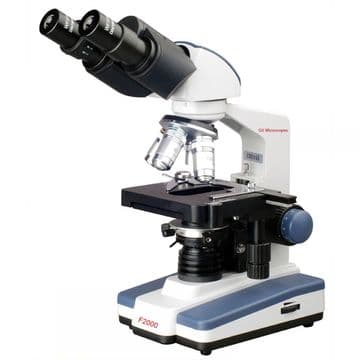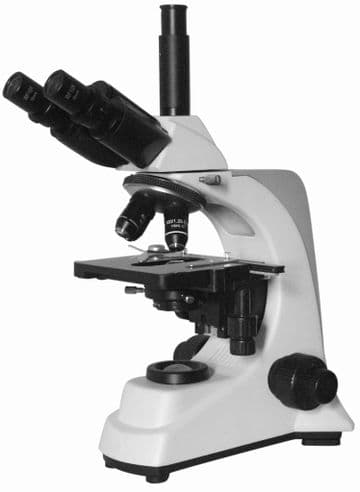Upright Biological Microscopes
Biological Upright Compound Microscopes are used for observing thin, transparent, slide mounted specimens under high magnifications typically ranging from 40X to 1000X. They are equipped with a bottom light which provides transmitted illumination through the specimen. Typical specimens suitable for observation using this type of microscope are, histology sections, thin sections of plant material, transparent parts of organisms such as insects, blood, cytological specimens, crystals and emulsions.
Biological Upright Compound Microscopes are most commonly purchased by amateur microscopists (although, it has to be said, usually by mistake!). If you want to look at, for instance, blood or 'invisible to the naked eye' waterborne creatures and if you want to use techniques such as phase contrast or fluorescence then this is what you need. If you want to look at whole 'lumpy' subjects like insects, minerals and plants with no or minimal sample preparation - do not buy this type of microscope, choose a stereo microscope or monozoom.TYPES
Biological Upright Compound Microscopes are available in a variety of types, you can choose from this range of heads:
- Monocular - a single eyepiece tube - these are the cheapest and smallest with the most basic optics typically. They are not designed for microphotography. You can mount a camera on them and we have adapters for this, but we do not recommend it for DSLRs especially.
- Binocular - two eyepiece tubes - these are very common but not the best for photography. You can mount a camera on them and we have adapters for this, but it is not ideal for several reasons, especially if the camera is a DSLR.
- Trinocular - these are the best type, especially for photography as they have a dedicated camera port - you will still need a microscope specific camera adapter in order to attach your camera and each type of camera has a camera specific connection at the camera end of the adapter, there are other considerations such as magnification and parfocality - it is easy to get this bit wrong - Ultramacro are experts in this field and manufacturers of adapters, we will be happy to advise.
Showing 7 of 7 results
-
GXM-L500LED Series 40X-400X Teaching, Biological, Monocular Microscopes Portable Version
From: £199.00 £238.80 (inc. VAT) -
GXM-L1000 Series 40X-1000X Teaching, Biological, Monocular Microscope With Portable Option
£240.46 £288.55 (inc. VAT)GXM-L1000 Series 40X-1000X Teaching, Biological, Monocular Microscope With Portable Option -
GXM-L1000 Series 40X-1000X Teaching, Biological, Monocular Microscope Portable
From: £244.99 £293.99 (inc. VAT) -
2000 Series 40X-2000X Routine Grade, Binocular Upright Microscope battery or mains powered
From: £228.33 £274.00 (inc. VAT)The 2000 series are our best value for money binocular biological microscopes.- Binocular head with interpupiliary adjustment and diopter adjustment
- Pair 10X Widefield FN18 and a pair of 20X Eyepieces (20X with ID0710 only)
- Quadruple nosepiece, 4X, 10X, 40X, 100X oil achromatic objectives
- Mechanical stage, coaxial coarse/fine focus, Abbe condenser on rack & pinion
-
Aspen GTC10 Trinocular Biological Microscope with LED Illumination
£455.13 £546.16 (inc. VAT)Aspen GTC10 Trinocular Biological Microscope with LED Illumination -
UM1075CTrinocular Biological Microscope with Infinity Optics and Koehler LED Illumination
£987.69 £1,185.23 (inc. VAT) £1,095.00UM1075C Trinocular Biological Microscope with Infinity Optics and Koehler LED Illumination -
UM1112C Series Unique Digital LCD Microscopes
From: £2,533.33 £3,040.00 (inc. VAT) £2,800.00The 'UM1112C' series of microscopes include a built-in high quality camera, high definition multifunctional HD screen, up to 16MP image resolution, up to 1080p video recording, SD card slot.







